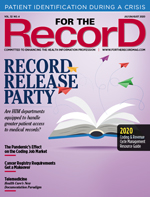July-August  2020
2020
Editor’s Note: Medical Record Access for All
By Lee DeOrio
For The Record
Vol. 32 No. 4 P. 4
A complicated illness exacts a heavy toll from frightened patients and their loved ones. Inevitably, the process will involve visiting various providers and organizations, most of which will require medical records to make the journey as well.
As anyone in the industry will tell you, that’s not always the simplest of endeavors. Even if providers reside on the same system, it’s not a guarantee that the records will travel well—if at all. For those on disparate systems, the challenge becomes even greater.
In all likelihood, the patient will have to request their records, including film, at some point. Government measures, such as those discussed in this month’s cover story, are designed to make this process patient-oriented. But, as we all know, not all patients have the same opportunities. Social determinants of health (SDOH) play a huge role in who can take advantage of the benefits being offered through federal initiatives.
For example, those without internet access or who can’t afford a smartphone can be left behind when it comes to medical record access. “There’s no internet access in parts of Texas,” says Kim Murphy Abdouch, MPH, RHIA, FACHE, a clinical associate professor and clinical coordinator in the department of HIM at Texas State University. “And what about those who can’t afford a computer or a smartphone?”
Citing the Healthy People 2020 initiative, Murphy Abdouch says progress has been made, especially in terms of interoperability and EHR standardization. Nevertheless, she believes the government could do more to make technology more accessible to those who lack the means to do so.
To close this digital divide, Murphy Abdouch points to initiatives such as the Community Reinvestment Act in Texas and other Department of Housing and Urban Development efforts. “I would expect that the current emphasis on racial inequality will shed additional light on the contribution of lack of access to technology,” she says.
Other SDOH at play include not knowing how to use or being uncomfortable with electronic access tools, having a disability that may impair the ability to access records, and lacking the transportation necessary to physically obtain the records, says Jaime James, MHA, RHIA, senior HIM consultant, legislative policy and compliance at Midwest Medical Records Association.
The fact that patients with several chronic conditions may see many providers only exacerbates the confusion surrounding access. “This is why it is incumbent upon HIM professionals to continue to educate our patients and consumers on the various options available in which to access their information,” James says.
James’ point about the role played by HIM professionals in promoting medical record access to all cannot be overstated. It doesn’t take much for a seemingly small piece of advice given to a patient to have life-altering effects.



